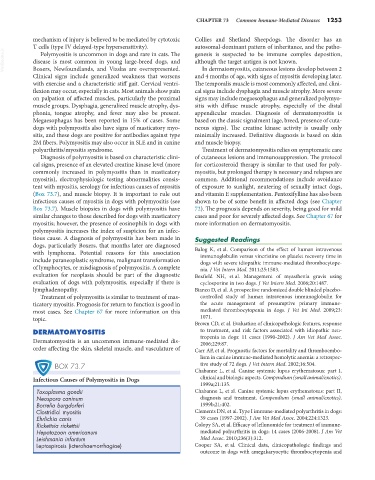Page 1281 - Small Animal Internal Medicine, 6th Edition
P. 1281
CHAPTER 73 Common Immune-Mediated Diseases 1253
mechanism of injury is believed to be mediated by cytotoxic Collies and Shetland Sheepdogs. The disorder has an
T cells (type IV delayed-type hypersensitivity). autosomal-dominant pattern of inheritance, and the patho-
VetBooks.ir disease is most common in young large-breed dogs, and genesis is suspected to be immune complex deposition,
Polymyositis is uncommon in dogs and rare in cats. The
although the target antigen is not known.
In dermatomyositis, cutaneous lesions develop between 2
Boxers, Newfoundlands, and Vizslas are overrepresented.
Clinical signs include generalized weakness that worsens and 4 months of age, with signs of myositis developing later.
with exercise and a characteristic stiff gait. Cervical ventri- The temporalis muscle is most commonly affected, and clini-
flexion may occur, especially in cats. Most animals show pain cal signs include dysphagia and muscle atrophy. More severe
on palpation of affected muscles, particularly the proximal signs may include megaesophagus and generalized polymyo-
muscle groups. Dysphagia, generalized muscle atrophy, dys- sitis with diffuse muscle atrophy, especially of the distal
phonia, tongue atrophy, and fever may also be present. appendicular muscles. Diagnosis of dermatomyositis is
Megaesophagus has been reported in 15% of cases. Some based on the classic signalment (age, breed, presence of cuta-
dogs with polymyositis also have signs of masticatory myo- neous signs). The creatine kinase activity is usually only
sitis, and these dogs are positive for antibodies against type minimally increased. Definitive diagnosis is based on skin
2M fibers. Polymyositis may also occur in SLE and in canine and muscle biopsy.
polyarthritis/myositis syndrome. Treatment of dermatomyositis relies on symptomatic care
Diagnosis of polymyositis is based on characteristic clini- of cutaneous lesions and immunosuppression. The protocol
cal signs, presence of an elevated creatine kinase level (more for corticosteroid therapy is similar to that used for poly-
commonly increased in polymyositis than in masticatory myositis, but prolonged therapy is necessary and relapses are
myositis), electrophysiologic testing abnormalities consis- common. Additional recommendations include avoidance
tent with myositis, serology for infectious causes of myositis of exposure to sunlight, neutering of sexually intact dogs,
(Box 73.7), and muscle biopsy. It is important to rule out and vitamin E supplementation. Pentoxifylline has also been
infectious causes of myositis in dogs with polymyositis (see shown to be of some benefit in affected dogs (see Chapter
Box 73.7). Muscle biopsies in dogs with polymyositis have 72). The prognosis depends on severity, being good for mild
similar changes to those described for dogs with masticatory cases and poor for severely affected dogs. See Chapter 67 for
myositis; however, the presence of eosinophils in dogs with more information on dermatomyositis.
polymyositis increases the index of suspicion for an infec-
tious cause. A diagnosis of polymyositis has been made in Suggested Readings
dogs, particularly Boxers, that months later are diagnosed Balog K, et al. Comparison of the effect of human intravenous
with lymphoma. Potential reasons for this association immunoglobulin versus vincristine on platelet recovery time in
include paraneoplastic syndrome, malignant transformation dogs with severe idiopathic immune-mediated thrombocytope-
of lymphocytes, or misdiagnosis of polymyositis. A complete nia. J Vet Intern Med. 2011;25:1503.
evaluation for neoplasia should be part of the diagnostic Bexfield NH, et al. Management of myasthenia gravis using
evaluation of dogs with polymyositis, especially if there is cyclosporine in two dogs. J Vet Intern Med. 2006;20:1487.
lymphadenopathy. Bianco D, et al. A prospective randomized double blinded placebo-
Treatment of polymyositis is similar to treatment of mas- controlled study of human intravenous immunoglobulin for
ticatory myositis. Prognosis for return to function is good in the acute management of presumptive primary immune-
most cases. See Chapter 67 for more information on this mediated thrombocytopenia in dogs. J Vet Int Med. 2009;23:
topic. 1071.
Brown CD, et al. Evaluation of clinicopathologic features, response
DERMATOMYOSITIS to treatment, and risk factors associated with idiopathic neu-
tropenia in dogs: 11 cases (1990-2002). J Am Vet Med Assoc.
Dermatomyositis is an uncommon immune-mediated dis- 2006;229:87.
order affecting the skin, skeletal muscle, and vasculature of Carr AP, et al. Prognostic factors for mortality and thromboembo-
lism in canine immune-mediated hemolytic anemia: a retrospec-
BOX 73.7 tive study of 72 dogs. J Vet Intern Med. 2002;16:504.
Chabanne L, et al. Canine systemic lupus erythematosus: part I,
Infectious Causes of Polymyositis in Dogs clinical and biologic aspects. Compendium (small animal/exotics).
1999a;21:135.
Toxoplasma gondii Chabanne L, et al. Canine systemic lupus erythematosus: part II,
Neospora caninum diagnosis and treatment. Compendium (small animal/exotics).
Borrelia burgdorferi 1999b;21:402.
Clostridial myositis Clements DN, et al. Type I immune-mediated polyarthritis in dogs:
Ehrlichia canis 39 cases (1997-2002). J Am Vet Med Assoc. 2004;224:1323.
Rickettsia rickettsii Colopy SA, et al. Efficacy of leflunomide for treatment of immune-
Hepatozoon americanum mediated polyarthritis in dogs: 14 cases (2006-2008). J Am Vet
Leishmania infantum Med Assoc. 2010;236(3):312.
Leptospirosis (icterohaemorrhagiae) Cooper SA, et al. Clinical data, clinicopathologic findings and
outcome in dogs with amegakaryocytic thrombocytopenia and

